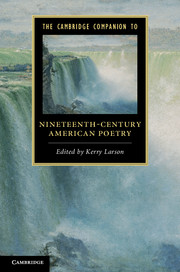Book contents
- Frontmatter
- Introduction
- I MANDATES, MOVEMENTS, AND MANIFESTOES
- 1 The reception of nineteenth-century American poetry
- 2 American Indian poetry in the nineteenth century
- 3 The poet as Poetess
- 4 Transcendentalist poetics
- 5 Slavery and its metrics
- 6 Weathering the news in US Civil War poetry
- 7 The “Twilight of the Poets” in the era of American realism, 1875–1900
- II INDIVIDUAL AUTHORS
- Selected guide to further reading
- Index
- Cambridge Companions to…
2 - American Indian poetry in the nineteenth century
from I - MANDATES, MOVEMENTS, AND MANIFESTOES
Published online by Cambridge University Press: 28 November 2011
- Frontmatter
- Introduction
- I MANDATES, MOVEMENTS, AND MANIFESTOES
- 1 The reception of nineteenth-century American poetry
- 2 American Indian poetry in the nineteenth century
- 3 The poet as Poetess
- 4 Transcendentalist poetics
- 5 Slavery and its metrics
- 6 Weathering the news in US Civil War poetry
- 7 The “Twilight of the Poets” in the era of American realism, 1875–1900
- II INDIVIDUAL AUTHORS
- Selected guide to further reading
- Index
- Cambridge Companions to…
Summary
Scholarship and teaching about nineteenth-century American poetry usually shows no awareness of American Indian poetry. Often, when the concept of American Indian poetry is even mentioned, it comes up only to note the supposed absence of poetry by American Indians, even though white American poets wrote so much about Indians. Rarely, scholars take note of two or three Indian poets, typically Jane Johnston Schoolcraft, John Rollin Ridge/ Yellow Bird, or Alex Posey, all writers known (when at all) more for their prose than for their poetry. Lamenting the absence of attention to early American Indian poetry, and suspecting that there must have been a good deal of it, I took up the not so extraordinary yet more or less unprecedented task of looking for it. When I looked, I found many poems, including far more poems by Schoolcraft, Ridge, and Posey than even the few scholars who attended to those writers had seen. I put together an anthology, Changing is Not Vanishing: A Collection of American Indian Poetry to 1930 that showcases the work of 83 poets, including 39 from the nineteenth century, and provides a bibliography listing the work of almost 150 Indian poets up to 1930, 51 of them from the nineteenth century. Drawing on that anthology, this chapter takes up the modest but in some ways – for the history of nineteenth-century American poetry – revolutionary task of introducing the range and preoccupations of early American Indian poetry.
- Type
- Chapter
- Information
- Publisher: Cambridge University PressPrint publication year: 2011



